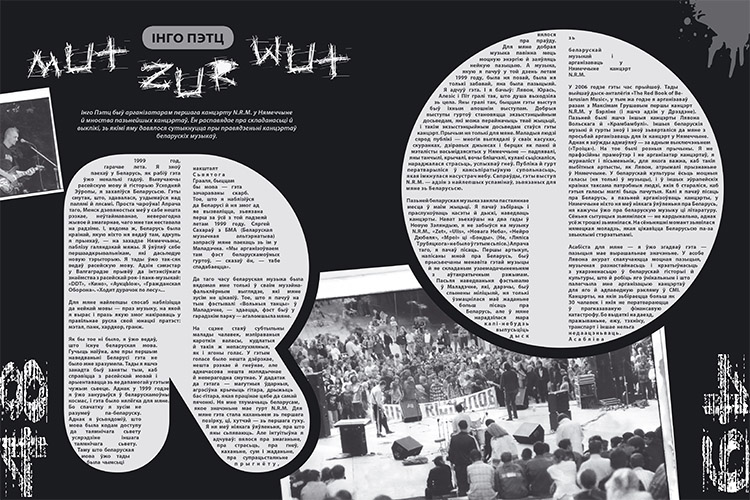
Аўтар: Natalja Haračaja, 07/04/2014 | ART Cult Aktivist project
THE SPACE OF ONE’S PRIVATE FOREST
In March 2014 the project «Angulum Ligno» was exhibited in the Contemporary Art Gallery «Ў». The installation bearing the same name was created by the artist Alena Haiduk in the framework of the gallery’s program «START» aimed at supporting the creative youth. In April the project was also presented in the exposition «Anatomy» at Viciebsk Marc Chagall art-center.
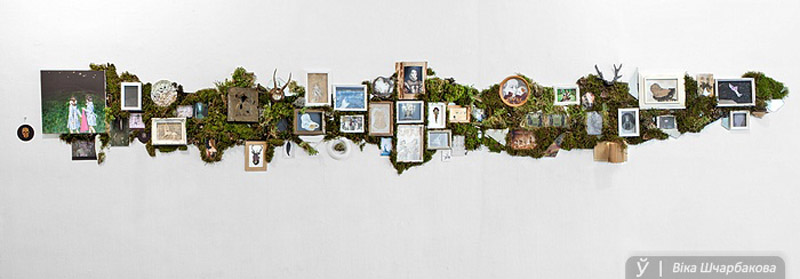
When speaking about a female artist exhibition, the central moment for reflection often shifts away from the actual works to the issue of the acceptable dose of the femininity in art. «Аngulum Ligno» is an example of an exclusively female approach with the artist’s personality herself becoming the installation’s protagonist. She creates objects in a manner that emphasizes her status and identity, and not only does she fails to feel shy about her own femininity, but presents it as a key factor of personal formation and self-identification.
Calling a spade a spade, we get rid of the eternal comparison and provocative gender competition.
Orthodox icon frames, the images of Catholic altar sculptures, the photographs of Gothic arches rests trigger only aesthetic feelings and do not transmit the symbolic meaning they used to have. The artist reveals one of role of her own – that of the observer. Architectural elements, historical and cultural artifacts, items of the religious nature are only objects of contemplation, endowed with artificial worship energy. Neglected and presenting little interest for a practising believer, the objects appeal for artistic representation. They abandoned their original meaning and are now free to be filled in with the new values.
All the items in Alena Haiduk’s installation depict the moment of here and now, they do not speak about the past, presenting a complete and perfect phenomenon of today.
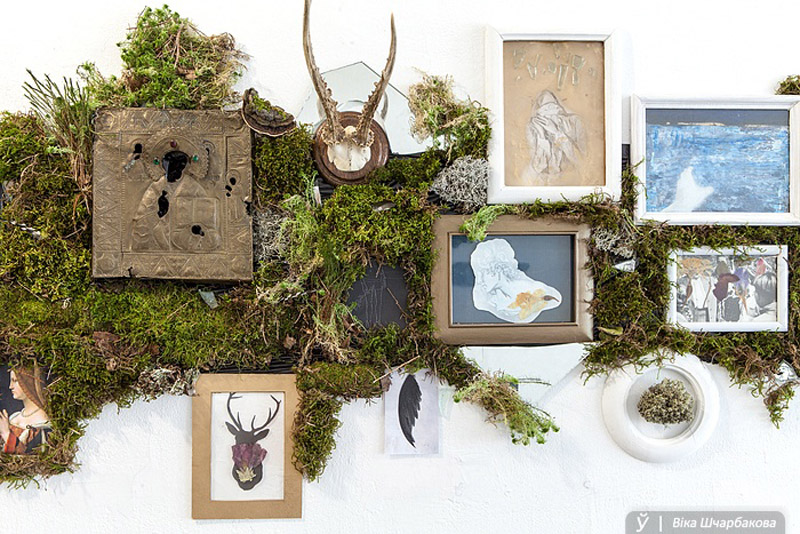
Certainly, in the objects’ selection for the installation beauty was the decisive factor. All the components are an example of seasoned beauty as perceived by the author. The question arises: whether it is this the beginning of a new aesthetics and plastic art, which has been so passionately looked for in the contemporary art by “old school” adopters?
Undoubtedly, «Аngulum Ligno» is a peculiar self-portrait of the artist’s: the story of her own reasons is transformed into compete creative works. Originally beautiful and easily understood things inspire images, all of them linked by a single theme – Alena’s personality. For the young artist exposing herself for study is the realization of the possibility to be perceived as one single essence, at the same time united in details and nuances.
Self-portrait is a way of looking at oneself from the outside, to understand oneself, to get to the roots, to evaluate . Alena Haiduk does not create a certain collective image, she simplifies the task and displays numerous components of her own portrait. Being rich in imagery, the visual material does not lose its integrity, unnecessary details do not make a part of the installation, despite the fact that the number of textures and images goes beyond ten — the holistic image is the author’s personality. Pictures, photographs, graphics and paintings, collages covered by natural living elements — moss, grass and tree branches, are organically intertwined and coexist harmoniously in «angulum ligno» space.
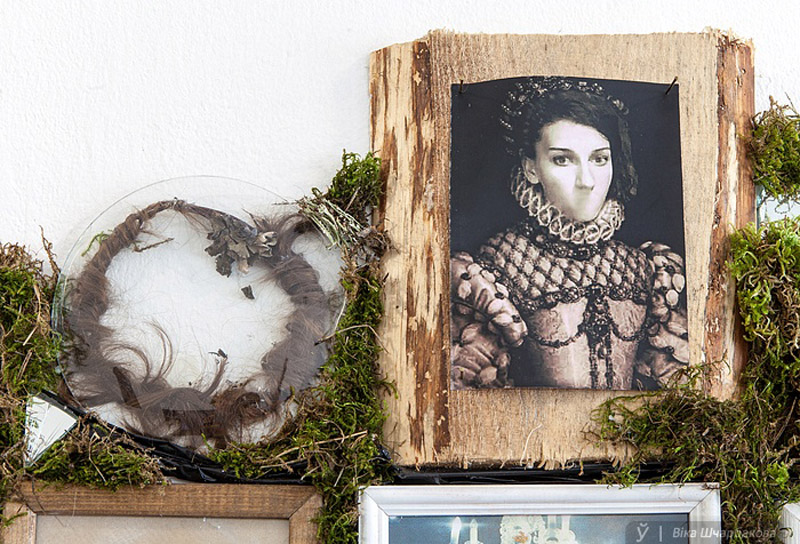
Alena emphasizes her belonging to nature, her indivisibility from it, as if justifying her “human origin”. The way nature gets restored after disasters: fields burned by fires are covered with growing green grass again, fallen trees are replaced by a new forest – the images and objects hidden by the moss gradually become a part of a new living natural organism, viable and victorious. Regardless of the degree of awareness, every artist adds exceptional value to nature. Plein-air sessions and drawing sketches from nature have always been the only immutable aesthetic ideal of creativity.
Alena Haiduk watches her self-portrait installation age, cover with growing moss and become a part of a sacred Latin angulum ligno.
Аngulum ligno is translated as «forest growing in the corner». The Latin name of the project drives us to the fact that the issue under the project’s consideration required a certain study, classification and naming. Аngulum ligno is a pseudoscientific title which systematizes objects that are of no interest to science. Feelings, individual experience, self-perception, verbalized in the dead language bring the topic of the project to the state of integrity and inviolability.
The central work presented in the installation work is the combination of the artist’s self-portrait and the figure in the noble medieval dress — a quintessential self-perception of the artist. The extraordinary straight posture and the open face look artificial for a modern portrait format and highlight the fact that not a direct reflection is meant but a self-image. In the self-portrait the lines of the mouth are missing and the eyes remain the only communication tool which clearly underlines the observer’s status. Admiration is the main function of this look, and this admiration is taken seriously since it becomes a basis for scientific research.
Alena Haiduk’s generation (born in the 1990s) cancelled from their memories numerous stereotypes which had been to a greater degree inherent to more mature people. The younger generation found a novel space where new, unexplored and yet unpraised values dominate. This unpraised aspect makes the values not less attractive for exploration, however being sometimes difficult to understand.
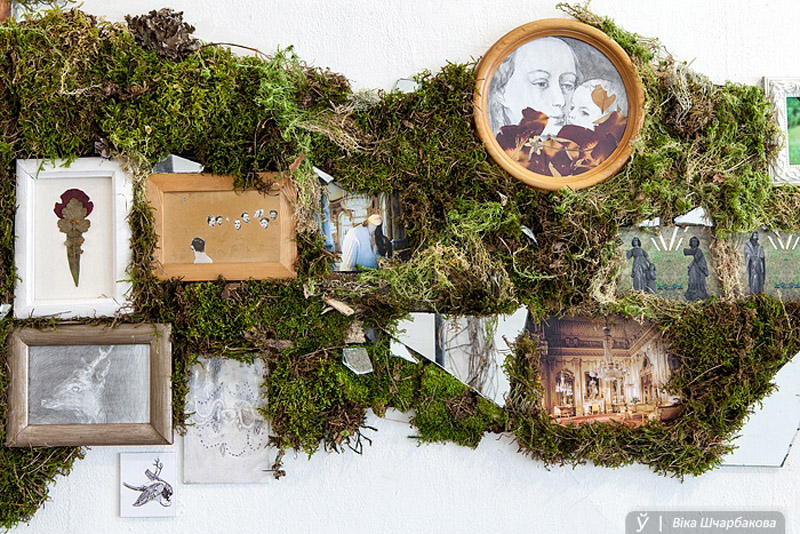
Video – a part of the installation «Angulum Lingo» — reflects an endless process of doing and undoing one’s braid. This process no longer carries, for example, meanings associated with this ritual in the past, such as adulthood or a woman’s marriage. In the interview at the exhibition’s opening the artist clearly refused the obsolete interpretations suggested to her. Moreover, they seemed strange and too artificial to her. Obviously, for the younger generation old traditions and symbols have completely lost their power. Common, widespread stereotypes not supported by the practice cease to exist for the coming generation — the process of information transmission associated with the symbols and values stopped being transmitted from grandmother to granddaughter. They are replaced by personal, intimate images which totally match the common, but not yet accepted ones.
Contemporary young art plays on this curiosity about new meanings and combinations with its central role of naming and disclosing, as well as coining new words.
Doing and undoing one’s braid in the installation «Angulum Ligno» became a way of mapping cycles and repetition, the routine of simple everyday intimate rituals and femininity. In the installation a new mythology is created, the discourse is built in the new language and according to the rules of new time. Belonging to nature, uncompromising obvious femininity are emphasized by the object made entirely from natural materials – creepers. A 2-meters’ braid exposed next to the video highlights its main message becoming a bridge between the digital image and natural materials.
The visual range of the project is composed of photographs of various parts of the body, hair, delicate hands and clothes. Apart from the endless masks of the artist’s, an outside observer notices in the installation his/her own personal self-portraits if not presented in picture then, without any duality, in the fragments of mirror that adorns the moss installation details. Old board, covered with moss, once formed a fragment of the church wooden altar in Glybokae area. Nearby villages were deserted, the church was no longer needed, it was abandoned and ruined. Covered with natural decor — moss and lichen — the board has become a symbol of immortality of the artist’s priorities — historical, religious, aesthetic and natural ones combined in one small object. Left unchanged, it became part of the installation.
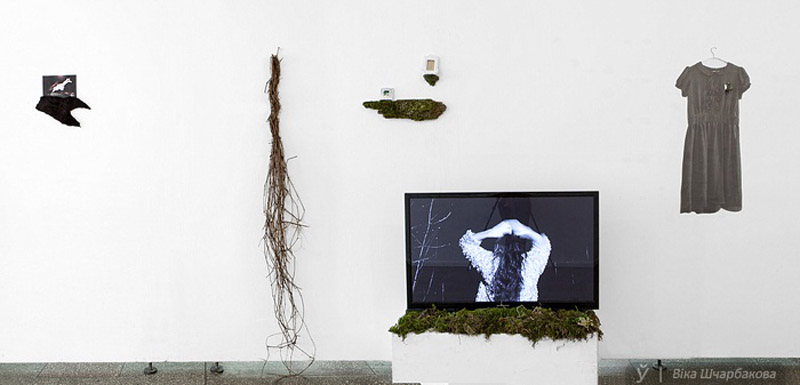
The seasonality of the forest is synchronous with cyclical periods and everydayness of life. It is emphasized in the video part of «Angulum Ligno» where natural and feminine origins get compared. All the author’s identity — or one of its parts — merges with the environment. Hidden from external interference, it develops naturally due to the inner necessity rather than through a stack of certain rules, “is covered with moss”, interwoven with grass and branches, becoming more natural and, thus justified by the nature. As a result it acquires a new status – the status of something existing.
At this stage all that interests her is creating her own aesthetic territory.
Forest in the corner is a private space, the realm of local character with unique components, devoid of any artificial association. Forest is a territory of wildness and naturalness, everything lives according to private laws, far from traditional limitations. Small intimate area contained in the familiar environment develops, creates its own ecosystem of experiences and views. In fact, angulum ligno is the condition of a person who lives in today’s Belarus, forced to create his/her own independent space at the disinfected, sterile territory of the country. Growing the living forest in the corner goes against the purified medium of the Belarusian modernity.
We have a situation where any self-sufficiency is poisoned and any free thinking essential for the personality formation is eradicated. Forest in the corner is a way out and the need of every self-conscious individual.
Forest in the corner are kitchen conversations, private parties with close friends, places of leisure and work, where the external interference is minimized or reduced to zero with the space formed exclusively according to one’s own rules and desires. Forest in the corner becomes relationships through which you can share secret desires – that is family, parish, community. Forest is subject to neither any structuring, nor any foreign laws. For healthy living a person needs just such a space, so the term “forest in the corner” may become a nomination.
Today the transformation of stereotypes as well as the replacement of obsolete concepts and creation of a new visual and sensual artistic language become obvious. Immensity — both informational and technical — forms an extensive base for development and creativity. The substitution of values occurs naturally, as a result of the devastating discrediting of the basic concepts of older times. Each period necessitates the formation of a new language that will accurately speak about this time and specify concepts. A very large number of references the artist uses reflects the conflict of the uncertainty of the new language. By now a large number of epithets for a thorough description of the phenomena that are experienced by everybody has been necessary.
It is needed to speak about the phenomena which are still kept secret, hidden in a thicket of the “forest in the corner”.
Natalja Haračaja
Photos by Vika Ščarbakova, translated by Volha Bubič
Opinions of authors do not always reflect the views of pARTisan. If you note any errors, please contact us right away.




